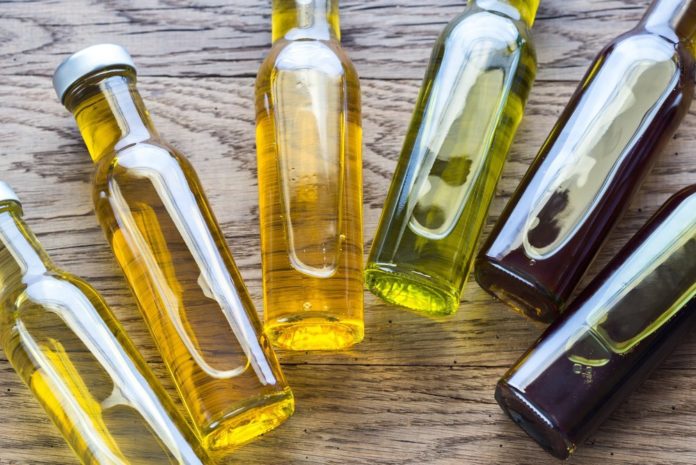Fun fact: human civilizations have used cooking oils from plants and nuts for thousands of years! A 4,000-year-old kitchen-like structure unearthed in Indiana contained evidence that American Indian tribes used to collect and crush hickory nuts before boiling them over a fire to collect their fatty oils. Fast forward to today, and oils are still an important ingredient in many recipes and cooking techniques.
Coconut oil, vegetable oil, olive oil, canola oil, avocado oil—which is the best? Some contain “good” fats, others…not so much. What’s more, different types of food pair better with certain oils than others, meaning it’s not always a case of choosing your favorite oil and using it for everything. Every cook should know his or her way around different cooking oils to bring out the best flavors in every recipe.
Extra Virgin Olive Oil
Olive oil comes from, well, olives. As such, it has a rich flavor, and can be buttery, spicy, fruity or grassy in nature, depending on the origin of the olives. Extra virgin olive oil smokes quite quickly when exposed to heat so it’s not the best for cooking or frying. However, EVOO is generally of such a high quality that it’s wonderful as a finishing oil or used in a dressing or vinaigrette. No cooking required! Regular olive oil (sometimes called “Light” or “Pure”) is much better for frying.
How to use with Tilapia: Use in a salad dressing, like this one, for a Tilapia fattoush salad.
Avocado Oil

Avocado oil is packed with vitamin E (important for skin and eye health), beta-sitosterol (a type of cholesterol that helps our bodies get rid of unhealthy fats) and oleic acid (which can assist in weight loss). It is a fine oil for grilling and deep frying, and its creaminess pairs well with firm seafood. You can also try it with fried eggs, stir fry, drizzled garnish or vinaigrettes.
How to use with Tilapia: Try making a salad dressing to pair with a Tilapia and avocado salad.
Coconut Oil
You may have heard people raving about the benefits of coconut oil for things like hair and skin health, but some people can be hesitant to use it in their cooking as they worry the coconut taste will overpower the meal. However, this oil is actually a very useful ally in the kitchen, owing to the fact it doesn’t degrade at high temperatures.
How to use with Tilapia: Coconut oil is great for pan-frying or deep-frying Tilapia.
Flaxseed Oil

Providing a hearty dose of fiber and protein, flaxseed oil is useful in reducing appetite and assisting with weight loss. However, it should never be heated and only consumed raw. As such, it’s a great addition to salads and smoothies. Flaxseed oil (also known as linseed oil) is also absorbed quite slowly by the body, meaning you should consume it in smaller quantities.
How to use with Tilapia: Drizzle flaxseed oil over a fresh salad topped with a grilled Tilapia fillet.
Sesame Oil
Sesame oil boasts a delicious nutty flavor that goes great with Chinese, Korean and south Indian dishes. This oil is rich in polyunsaturated and monounsaturated fats, while also low in saturated fats, making it a great addition to a healthy diet. To keep it fresh, store sesame oil in the fridge.
How to use with Tilapia: Use sesame oil in a marinade for Tilapia fillets.
Peanut Oil

While peanut oil can be found in many Southeast Asian dishes, you have to be careful when using it. It has a strong flavor, which doesn’t lend itself well to just any dish. However, it can tolerate high heats and works well with dishes that already contain, or could conceivably contain, nuts of some kind. Do note though that peanut oil goes bad faster than other oils, so only buy it in small quantities if you won’t be using it often.
How to use with Tilapia: Add peanut oil to a Tilapia-centric stir fry.
Vegetable Oil
You’re probably familiar with vegetable oil. It used to be the go-to for most of the work done in the kitchen. We now know that this is not the best idea. Vegetable oils contain the bad kind of fats, and can cause inflammation within the body. We have many better options available to us, but its neutral flavor and ability to heat well makes it a good option when deep frying on occasion.
How to use with Tilapia: Use vegetable oil when breading and frying Tilapia.
Every oil has its own flavors and properties that make different ones better in certain situations and worse in others. So, instead of reaching for the same old bottle of oil for everything, have some fun and experiment in the kitchen!
Oils can be a source of many vitamins and nutrients. Are you getting enough in your diet? Check out our A to Z of Vitamins for more nutritional tips and tricks.
Eager to try this recipe at home? Consult our store locator to find your nearest Tilapia retailer.
Photo Credits: Alexander Prokopenko / Shutterstock Inc., EKramar / Shutterstock Inc., bitt24 / Shutterstock Inc., AS Food studio / Shutterstock Inc.






